| Posted: Dec 03, 2014 |
Buckyballs enhance carbon capture
|
|
(Nanowerk News) Rice University scientists have discovered an environmentally friendly carbon-capture method that could be equally adept at drawing carbon dioxide emissions from industrial flue gases and natural gas wells.
|
|
The Rice lab of chemist Andrew Barron revealed in a proof-of-concept study that amine-rich compounds are highly effective at capturing the greenhouse gas when combined with carbon-60 molecules.
|
|
Carbon-60 molecules, also known as buckyballs, were combined with amines in a compound that absorbs a fifth of its weight in carbon dioxide. It shows potential as an environmentally friendly material for capturing carbon from natural gas wells and industrial plants. Courtesy of the Barron Research Group
|
|
The research is the subject of an open-access paper today in Nature’s online journal Scientific Reports ("Cross-Linking Amine-Rich Compounds into High Performing Selective CO2 Absorbents").
|
 |
| Carbon-60 molecules, also known as buckyballs, were combined with amines in a compound that absorbs a fifth of its weight in carbon dioxide. It shows potential as an environmentally friendly material for capturing carbon from natural gas wells and industrial plants. (Courtesy of the Barron Research Group)
|
|
“We had two goals,” Barron said. “One was to make the compound 100 percent selective between carbon dioxide and methane at any pressure and temperature. The other was to reduce the high temperature needed by other amine solutions to get the carbon dioxide back out again. We’ve been successful on both counts.”
|
|
Tests from one to 50 atmospheric pressures showed the Rice compound captured a fifth of its weight in carbon dioxide but no measurable amount of methane, Barron said, and the material did not degrade over many absorption/desorption cycles.
|
|
Carbon-60, the soccer ball-shaped molecule also known as buckminsterfullerene (or the “buckyball”) was discovered at Rice by Nobel Prize laureates Richard Smalley, Robert Curl and Harold Kroto in 1985. The ultimate curvature of buckyballs may make them the best possible way to bind amine molecules that capture carbon dioxide but allow desirable methane to pass through.
|
|
The Rice lab used buckyballs as crosslinkers between amines, nitrogen-based molecules drawn from polyethyleneimine. The lab produced a brown, spongy material in which hydrophobic (water-avoiding) buckyballs forced the hydrophilic (water-seeking) amines to the outside, where passing carbon dioxide could bind to the exposed nitrogen.
|
|
When Barron and his team began combining carbons and amines several years ago, they noticed an interesting progression: Flat graphene absorbed carbon dioxide well, multiwalled nanotubes absorbed it better, and thinner single-walled nanotubes even better. “That suggested the curvature was important,” Barron said. “C-60, being a sphere, has the highest possible curvature among carbon materials.”
|
 |
| Polyethyleneimine (PEI) with carbon-60 atoms, aka buckminsterfullerenes, form a spongy brown compound that absorbs a fifth of its weight in carbon dioxide but no measurable amount of methane. That may make it suitable for capturing carbon dioxide at wellheads and from industrial flue gases. (Courtesy of the Barron Research Group)
|
|
He said the Rice compound compared favorably with other carbon-capture candidates based on metal organic frameworks (MOFs). “It’s about equivalent to the best MOFs for carbon capture, but our material is far more selective. Methane just doesn’t absorb,” Barron said. Unlike MOFs, he noted the Rice compound absorbed wet carbon dioxide as well as dry.
|
|
Barron said it’s just as important that the compound release carbon dioxide efficiently for reuse. “We noticed a long time ago that if we attached amines to carbon nanotubes or graphene, they lowered the temperature at which carbon dioxide dissolves,” Barron said. Industrial amine-based scrubbers must be heated to 140 degrees Celsius to release captured carbon dioxide; lowering the temperature would save energy.
|
|
“Compared to the cost of current amine used, C-60 is pricy,” Barron admitted. “But the energy costs would be lower because you’d need less to remove the carbon dioxide.” He noted industrial scrubbers lose amines through heating, so they must constantly be replenished. “They’re forever adding reagent, which is nice for the companies that sell amine, but not so good for those trying to separate the carbon dioxide.”
|
|
The researchers are pursuing ways to improve the compound’s capacity and rate of absorption. “We really understand the mechanism, which is important,” Barron said. “That allows us to push it further.”
|


